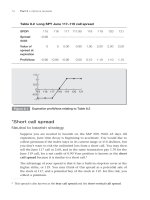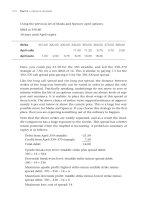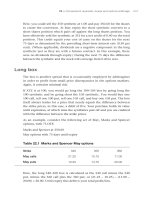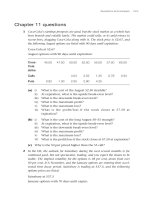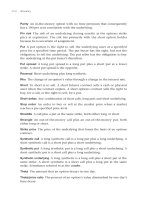Every landlords guide to managing property best practices, from move in to move out, 2nd edition
Bạn đang xem bản rút gọn của tài liệu. Xem và tải ngay bản đầy đủ của tài liệu tại đây (2.99 MB, 455 trang )
“The ultimate property management guide for do-it-yourself
landlords who own a single-family house, condo, or duplex.”
DOITYOURSELF.COM
2ND EDITION
Every Landlord’s Guide
to
Managing
Property
• Get and keep good tenants
• Stay on top of repairs, maintenance,
& tax deductions
• Avoid vacancies and cash flow problems
Best Practices,
From Move-In to Move-Out
Attorney Michael Boyer
Practical advice for managing and growing a successful rental property business
Praise for Every Landlord’s Guide to Managing Property
“Every Landlord’s Guide to Managing Property: Best Practices
From Move-In to Move-Out, by Michael Boyer is a MUST HAVE
for anyone who is currently a landlord or even thinking about
becoming a landlord. The author, Michael Boyer, is obviously a
seasoned professional and landlord who has taken the time to pass on
his secrets to success so that you can avoid the many mistakes that (all
too often) do-it-yourself landlords make.
It is well written and takes the mystery out of why some landlords are
ultra successful and have great relationships with their tenants, while
others have nothing but nightmare experiences that lead them to lose
money, sell their rental property, and seek financial shelter in other
(often less profitable) investments.
This book also provides detailed and practical advice on how to
acquire and perfect technical skills involving property management
(from property and tenant selection to when to do work yourself
and when to call in a professional); people skills involving tenants
(including how to attract and keep great tenants and how to work
well with them once you have them); along with general management
skills involving everything from short- and long-term planning to
basic financial management. The advice and examples in this book
will enhance the desirability of owning your existing rental property or
help you select a new rental property, decrease the stress level and long
term cost associated with being a landlord, and ultimately increase the
success of your property investment business.
I cannot recommend this book more highly.”
—Gary Ransone, Esq.
General Contractor, Real Estate Broker, Property Manager,
and Author of The Contractor’s Legal Kit
“The ultimate property management guide for do-it-yourself landlords
who own a single-family house, condo, or duplex. The best do-it-yourself
landlording book on the market, packed with tips every DIY’er will love.”
—DoItYourself.com
“The rental market continues to grow even as the for-sale market
recovers. Rents are rising and inventory is dropping, and the gap
is being filled increasingly by small landlords with just one or two
properties. Michael Boyer’s Every Landlord’s Guide to Managing
Property is a must-have survival guide for newcomers to the market.”
—Alan J. Heavens
Residential Real Estate Columnist, Philadelphia Inquirer
This Book Comes With Lots of
FREE Online Resources
Nolo’s award-winning website has a page
dedicated just to this book. Here you can:
KEEP UP TO DATE. When there are important
changes to the information in this book, we’ll
post updates.
And that’s not all.
Nolo.com contains
thousands of articles
on everyday legal and
business issues, plus
GET DISCOUNTS ON NOLO PRODUCTS. Get
a plain-English law
discounts on hundreds of books, forms, and
dictionary, all written by
software.
Nolo experts and available
READ BLOGS. Get the latest info from Nolo
for free. You’ll also find
authors’ blogs.
more useful books,
LISTEN TO PODCASTS. Listen to authors
discuss timely issues on topics that interest you.
WATCH VIDEOS. Get a quick introduction to a
software, online apps,
downloadable forms,
plus a lawyer directory.
legal topic with our short videos.
Get updates and more at
LAW for ALL
www.nolo.com/back-of-book/PROP.html
The Trusted Name
(but don’t take our word for it)
“ In Nolo you can trust.”
THE NEW YORK TIMES
“ Nolo is always there in a jam as the nation’s premier publisher
of do-it-yourself legal books.”
NEWSWEEK
“ Nolo publications…guide people simply through the how,
when, where and why of the law.”
THE WASHINGTON POST
“ [Nolo’s]…material is developed by experienced attorneys who
have a knack for making complicated material accessible.”
LIBRARY JOURNAL
“ When it comes to self-help legal stuff, nobody does a better job
than Nolo…”
USA TODAY
“ The most prominent U.S. publisher of self-help legal aids.”
TIME MAGAZINE
“ Nolo is a pioneer in both consumer and business self-help
books and software.”
LOS ANGELES TIMES
2nd Edition
Every Landlord’s Guide
to Managing Property
Best Practices, From Move-In to Move-Out
Attorney Michael Boyer
LAW for ALL
SECOND EDITION
JANUARY 2018
Editors
MARCIA STEWART
ILONA BRAY
Book Design
SUSAN PUTNEY
Proofreading
IRENE BARNARD
Index
JULIE SHAWVAN
Printing
BANG PRINTING
Names: Boyer, Michael (Property manager), author.
Title: Every landlord’s guide to managing property : best practices, from
move-in to move-out / Michael Boyer.
Description: 2nd Edition. | Berkeley, CA : Nolo, [2017] | Revised edition of
the author’s Every landlord’s guide to managing property, [2015] |
Includes index.
Identifiers: LCCN 2017026691 (print) | LCCN 2017031145 (ebook) | ISBN
9781413324228 (ebook) | ISBN 9781413324211 (pbk.)
Subjects: LCSH: Real estate management.
Classification: LCC HD1394 (ebook) | LCC HD1394 .B69 2017 (print) | DDC
333.5068--dc23
LC record available at />This book covers only United States law, unless it specifically states otherwise.
Copyright © 2015 and 2017 by Nolo. All rights reserved. The NOLO trademark is
registered in the U.S. Patent and Trademark Office. Printed in the U.S.A.
No part of this publication may be reproduced, stored in a retrieval system, or
transmitted in any form or by any means, electronic, mechanical, photocopying,
recording, or otherwise without prior written permission. Reproduction prohibitions
do not apply to the forms contained in this product when reproduced for personal
use. For information on bulk purchases or corporate premium sales, please contact
the Special Sales Department. Call 800-955-4775 or write to Nolo, 950 Parker Street,
Berkeley, California 94710.
Please note
We believe accurate, plain-English legal information should help you
solve many of your own legal problems. But this text is not a substitute
for personalized advice from a knowledgeable lawyer. If you want the
help of a trained professional—and we’ll always point out situations
in which we think that’s a good idea—consult an attorney licensed to
practice in your state.
Acknowledgments
Special thanks to Marcia Stewart and Ilona Bray for stellar editing
and helping make this book a readable reality.
This book is dedicated to small-time landlords everywhere,
the men and women who roll up their sleeves to make a big-time
difference through housing others.
About the Author
Michael Boyer is a part-time landlord, college professor, and
attorney. He has graduate degrees in management and law, plus over
a decade of experience as a successful do-it-yourself landlord. He has
been on both sides of the landlord-tenant equation, as a landlord
and as a volunteer attorney representing low-income tenants. Boyer
is the author of numerous articles and chapters, and has served on
many boards, including several condominium association boards.
This is his first book and it is a culmination of years of collecting
notes, tips, and day-to-day observations about what practices really
work for the small-time landlord (especially one with a day job).
Table of Contents
Part-Time Residential Landlords:
The Superheroes of Rental Housing..............................................................................1
Filling a Gap in the Landlord Literature...............................................................................3
The Long-Term Landlord............................................................................................................4
How Skills You Currently Have or Can Easily Acquire) Will Contribute
to Your Success...........................................................................................................................6
Why I Like Being a Landlord...................................................................................................10
What You Won’t Find in This Book..................................................................................... 15
Your Competitive Edge?................................................................................... 19
1 What’s
Get to Know Your Market and Where Your Rental Fits Within It........................ 21
Differentiate Your Units From the Competition..........................................................22
Offer Lower-Priced Units by Focusing on Keeping Long-Term Tenants.............25
Make Strategic Decisions About Your Own Approach to Renting Property......26
Consider Whether an LLC Is Right for You......................................................................30
What’s Next?................................................................................................................................. 31
Rental Properties..............................................................................................33
2 Selecting
Location, Location, Location..................................................................................................35
What Type of Rental Property Is Best for You?..............................................................38
Single-Family House...................................................................................................................39
Duplex, Triplex, and Fourplex................................................................................................ 41
Condominium..............................................................................................................................44
Accessory Apartment (or In-Law).......................................................................................49
The Rental Market and Your Target Tenant....................................................................50
Choosing the Right Property: Don’t Leave It to Chance...........................................53
How to Make Sure the Rental Property Pencils Out...................................................54
Finding Out All You Can About a Prospective Property.......................................... 61
Arranging a Professional Inspection...................................................................................67
Making an Informed Decision When Choosing a Rental Property......................70
Guidelines for Buying an Occupied Unit .........................................................................71
What’s Next?.................................................................................................................................73
Your Inner Handyperson: Tips and Tricks................................75
3 Discovering
Your Basic Skills, Toolkit, and Supplies..............................................................................77
Washing Painted Walls.............................................................................................................83
Refinishing Wooden Cabinets...............................................................................................84
Painting............................................................................................................................................85
Using a Drill....................................................................................................................................91
Caulking...........................................................................................................................................92
Dealing With Drains...................................................................................................................94
Toilet Troubleshooting.............................................................................................................94
Dealing With Moisture and Mold..................................................................................... 100
Ways to Boost Your Repair and Maintenance IQ and Effectiveness................. 102
What’s Next?.............................................................................................................................. 105
Your Rental Unit for Tenants............................................................... 107
4 Preparing
Understanding Fair Rental Condition for Your Market.......................................... 109
To Furnish or Not to Furnish...............................................................................................111
Preparing for New Tenants...................................................................................................112
Establishing a Cleaning and Repair Routine..................................................................113
Walls and Ceilings.....................................................................................................................115
Floors and Floor Coverings...................................................................................................116
Pet, Tobacco, and Other Odors..........................................................................................119
Kitchen and Appliances.........................................................................................................122
Bathrooms....................................................................................................................................128
Light Fixtures and Outlets.....................................................................................................129
Doors and Windows................................................................................................................129
Closets............................................................................................................................................129
Smoke Detectors, Fire Extinguishers, and Carbon Monoxide Detectors........131
Perimeter and Outside...........................................................................................................131
Marshalling Your Materials and Supplies.......................................................................134
The Minor Remodel: Doing It on the Cheap................................................................136
Handing Off the Turnaround Work: Hiring Help.......................................................138
What’s Next?...............................................................................................................................138
Art of Rental Maintenance...................................................................................139
5 The
Maintenance—It’s About Tenant Satisfaction, Too!................................................ 140
Learning What Level of Maintenance and Repairs the Law Requires................141
Developing a Maintenance Mentality.............................................................................143
Do-It-Yourself Maintenance Helps You Keep an Eye on the Property..............143
Establishing the Maintenance Habit.................................................................................147
Common Maintenance Cues: A Seasonal Routine....................................................150
Making a Maintenance Record and Keeping It Up....................................................161
What’s Next.................................................................................................................................162
With Service Contractors......................................................................... 163
6 Working
Who’s a Contractor?............................................................................................................... 166
When It Makes Sense to Hire Contractors................................................................... 166
Choosing Contractors.............................................................................................................178
Hiring a Handyperson............................................................................................................ 183
Making Sure the Worker Is an Independent Contractor
(Not an Employee)...............................................................................................................185
Getting Bids and Estimates From Contractors........................................................... 189
Signing a Contract................................................................................................................... 194
Your Role While the Work Is Being Done..................................................................... 196
Keep the Big Picture in Mind.............................................................................................. 201
What’s Next?.............................................................................................................................. 201
Great Tenants...................................................................................................... 203
7 Getting
Developing a Tenant Screening and Selection Plan.................................................. 206
Complying With Antidiscrimination Laws................................................................... 207
Managing Prospective Tenants’ First Impressions..................................................... 209
Crafting Your Advertisement or Posting........................................................................211
Sample Rental Ad......................................................................................................................214
Should Your Ad Include Exact Street Address and Photos?..................................219
Making Initial Contact With Prospective Tenants.................................................... 220
Emailing Rental Applications to Interested Parties................................................... 225
Final Steps in Preparing Your Rental for Showing to Prospects.......................... 226
Setting Up and Staggering Your Showings................................................................... 230
Closing the Door on Traditional Open Houses.......................................................... 234
Your “Sales Pitch” During Showings................................................................................. 236
When to Start Screening Prospective Tenants........................................................... 240
Developing Your Screening Criteria and Procedures................................................241
Great Screening Begins With a Thorough Rental Application.............................243
Top Criteria for Choosing Good Tenants...................................................................... 244
Screening for Pets..................................................................................................................... 252
Pros and Cons of Credit Checks........................................................................................ 254
Guidelines for Evaluating Rental Applications and Credit Reports................... 256
Choosing a Tenant................................................................................................................... 259
Rejecting Applicants............................................................................................................... 260
What’s Next?.............................................................................................................................. 262
the Tenancy Right: Lease Terms and Onboarding Process..... 263
8 Starting
Key Terms to Include in Your Lease or Rental Agreement.................................... 264
Where to Find Lease and Rental Agreement Forms................................................ 280
Signing the Lease or Rental Agreement......................................................................... 281
Making Cosigner Situations Work.................................................................................... 283
Tenant Onboarding Process................................................................................................ 286
Creating Tenant Files.............................................................................................................. 298
What’s Next?.............................................................................................................................. 298
Landlord Communications..................................................................... 299
9 Effective
Best Practices for Landlord Communications............................................................. 302
Handling Common Tenant Communications.............................................................315
Communicating About Delays in Rent Payment....................................................... 320
More Strategies for Serious Late-Rent Situations...................................................... 326
Communicating About Unauthorized Occupants................................................... 330
Responding to Requests to Add a Roommate.............................................................337
Communicating With Tenants Who Break the Lease............................................. 340
Communicating With Tenants About Other Common Issues........................... 348
Communicating About Tenants’ Pets..............................................................................352
Handling Conflicts Large and Small..................................................................................355
Formal Conflict Resolution for the Landlord...............................................................359
Who Should Handle Evictions: You, or an Attorney?.............................................. 360
What’s Next?...............................................................................................................................361
Tenants Out.......................................................................................................... 363
10 Moving
How a Tenancy Ends............................................................................................................... 364
Four Major Move-Out Pitfalls to Avoid......................................................................... 365
Preparing a Move-Out Letter............................................................................................. 366
Reviewing Your Security Deposit Return Rules.......................................................... 368
Green Tips for Moving Out With Minimal Waste.....................................................371
The Landlord Cycle: Preparing for the Next Move-In...............................................375
What’s Next?...............................................................................................................................375
and Using Professional Services............................................ 377
11 Understanding
Lawyers and Legal Help for the Small-Time Landlord..............................................378
Accountants and Tax Help for the Small-Time Landlord....................................... 388
Insurance Professionals and Coverage for Your Rental Property....................... 395
Other Helpful Professionals................................................................................................. 401
Property Managers.................................................................................................................. 402
How Professionals Can Help With Your Exit Strategy.............................................406
What’s Next?..............................................................................................................................408
Landlord Income and Expenses for Tax Time............................. 409
12 Tracking
Where You’ll Report Income and Deductions: Schedule E....................................410
Looking at Schedule E.............................................................................................................413
Don’t Sweat a Tax Loss (Especially in Your Early Years).......................................... 423
Keeping Records of Your Income and Expenses.........................................................424
What’s Next?.............................................................................................................................. 428
Index.......................................................................................................................................................... 429
Part-Time Residential Landlords:
The Superheroes of Rental Housing
Filling a Gap in the Landlord Literature.....................................................................3
The Long-Term Landlord......................................................................................................4
How Skills You Currently Have (or Can Easily Acquire)
Will Contribute to Your Success..................................................................................6
Property Oversight and Maintenance Skills..........................................................6
Interpersonal (People) Skills...........................................................................................7
General Management Skills............................................................................................8
Why I Like Being a Landlord........................................................................................... 10
What You Won’t Find in This Book............................................................................. 15
Large-Scale Property Management Tips or Practices.................................... 15
General Real Estate Investment Strategies.......................................................... 16
Flipping................................................................................................................................... 16
Renting Your Home Through Short-Term Vacation Rental Sites............ 16
Your State’s Landlord-Tenant Laws......................................................................... 18
2 | EVERY LANDLORD’S GUIDE TO MANAGING PROPERTY
W
hether you’re simply exploring the idea of being a landlord or are already renting out property, you’re in good
company. Small-time landlords—real people like you—
house much of the United States’ tenant population, in single-family
homes, condos, or multiplexes (such as a duplex, triplex, or fourplex).
What Type of Property Do Most Renters Live In?
Residential properties (defined as one to four units), the staple of smalltime landlords, provide much of the rental housing in the U.S. Recent
Census data located 44 million renter-occupied housing units, of which
well over half are small residential properties:
• single-family homes: 15.2 million
• two-to-four units (duplex, triplex, or fourplex, also known as
quads): 7.8 million, and
• mobile homes: 1.9 million.
Source: U.S. Census Bureau, 2015. American Community Survey,
updated October 2016.
As one of these small-time residential landlords, I’ve learned a lot
in my ten years of owning and managing residential rental property.
I started out in this business when, rather than selling a condo
that our family outgrew, I simply rented it out. I soon repeated the
process so that I had four condo rentals, and then added a fourplex.
Like many residential rental property owners, I have a day job.
Many times on my way to or from work, I do a quick change of
clothes (and change of roles), from college professor to landlord. As a
small operator without a staff, I am a hands-on property manager.
I’ve never changed clothes in a phone booth or leapt a tall building
in a single bound, but with some exceptions (such as when I need to
hire a contractor) I do everything myself—from choosing tenants
to unclogging toilets. This book is about this endeavor, a guide
specifically for the part-time landlord balancing a rental property with
work and life. It is written for the mild-mannered office worker by
INTRODUCTION | PART-TIME RESIDENTIAL LANDLORDS | 3
day, who may change into work clothes by night in order to clean and
paint walls, just in time to show a rental unit that weekend. And while
there are no diabolical villains (though I once inherited a tenant who
was close) or trains heading off a cliff, this book is about managing
regular people and keeping a residential property from going off the
tracks—making it clean, safe, and well maintained.
Filling a Gap in the Landlord Literature
While I read everything I can on real estate and residential rental
properties, the primary guide I used in writing this book was my
own experience as a part-time landlord. For example, the chapter on
turnarounds (in which you get a unit ready for the next tenant) was
from my years of notes on streamlining the process, and the tenantselection and lease-signing practices described in this book are all
largely my own practices, as well. That said, not every tip will work
for every landlord or property, and I’m sure you will develop a few of
your own tricks of the trade.
When I began, there was no detailed guide for what I would be
doing. While there were some great books out there for professional
landlords with apartment buildings and other major holdings,
none really spoke directly to the part-time landlord with just a few
residential rentals. And many books were short on details, just giving
general landlording advice that, while sound, was quite vague: select
great tenants, maintain your property, move tenants in, move them
out, and so on. So the crucial granular detail of how to do all this
was lacking. My goal in writing this book was to show exactly how
I choose a rental property, create an ad, screen tenants, prep a unit,
and even move out a tenant—everything I learned along the way.
Many books are also geared to larger operations. Some just tell
property managers to have their staff or hired help handle all the
details while they work the phone. But as a small-scale landlord, you
won’t have a staff, and you can afford to hire out only occasional
jobs that you can’t do better yourself. This book does cover hiring
service contractors (Chapter 6) and using professional services
4 | EVERY LANDLORD’S GUIDE TO MANAGING PROPERTY
(Chapter 11). But for the day-to-day work, the person assigned to
handle all the details will be the one in the mirror (you).
The day-to-day work will contribute to your success and help you
attract and retain good long-term tenants. I wrote this book to share
the how and to cover the details. We will survey the skills, strategies,
and general philosophy that can help the part-time landlord—from
choosing the type of rental property that works for you (whether
it’s a single-family house, a condo, or a multiplex) to keeping every
part of your rental units working smoothly; from communicating
clearly and often with tenants to providing great service from move
in through move out.
Each chapter covers a new area and is designed for part-time
landlords—the people housing others in their spare time—the
schoolteacher renting out a condo, the government worker with a
duplex, or the semiretired person with several single-family homes.
I feel these part-time landlords are modern superheroes of the U.S.
rental housing market. They may not wear a cape or mask (speaking
of detail, we’ll even cover what a landlord can and should wear!), but
they do amazing things—from refinishing dull cabinets to handling
complex tax deductions. And the public benefits from their efforts to
house others in their spare time.
The Long-Term Landlord
Being a landlord is not about overnight success, but instead the
ultimate long game. My approach is the exact opposite of the real
estate shenanigans depicted on late-night, get rich-quick infomercials
or reality television shows. Those may provide good entertainment
or clever marketing. But slow and steady—mowing lawns, painting
walls, shoveling snow, screening and communicating with tenants—
week in and week out, year after year, wins the race for part-time
landlords. The real gains will come over the very long term (think
years, not months).
You’ve probably heard the phrase “buy and hold”—that is, to
make money, a landlord should just purchase property, rent it out,
and hold it a decade or two before selling at a profit. It is a common
INTRODUCTION | PART-TIME RESIDENTIAL LANDLORDS | 5
mantra in real estate investment. You’ve probably even seen it work,
as real estate appreciates and rents rise over time.
But what’s left out of the simple buy-and-hold equation, are the
details of what you do in the meantime (the day-to-day property
management) during the years that you try and hold onto the
property. And the proverbial devil is in the details, because it’s tough
to engage in an activity for many years that you do not understand
or find meaningful in some way. Fortunately, beyond financial gain,
there are less talked about benefits of being a landlord (see my list
of why I like being a landlord, below). And you’ll find many of the
other details in the best practices laid out within this book.
One of the top tips for holding a property long term is to select
and retain long-term tenants. Most of a landlord’s labor will be in
this turnaround and rerenting process. But a tenant with a one-year
lease may even renew a time or two, so your work (and money) can
pay off in the following landlord’s magic formula:
• you will have fewer costly turnovers and no or low vacancies
• over time, rents will rise but your mortgage will stay the same
(if you have a fixed-rate mortgage)
• the value of your rental property will gradually appreciate, and
• tenants will pay down your mortgage with their rents,
reducing your debt and increasing your equity in the property.
These four factors, combined with the power of financial
leverage (most landlords put down 10%–20% of the purchase
price but retain 100% of the upside appreciation), make a winning
combination for long-term wealth building.
This sounds like a fail-proof proposition, but bear in mind
that the appreciation in property markets can be sporadic (real
estate moves in cycles). It may take decades for major profits to
emerge. That’s why landlords should focus on the long term,
allowing appreciation to march slowly upwards—even if in fits and
starts. Inflation will naturally drive up the rents in most markets,
increasing your cash flow.
Another key advantage of owning residential rental properties is
that they fit into many 30-year fixed-rate loan programs (ideal for
a long-term approach) with more favorable terms than properties
6 | EVERY LANDLORD’S GUIDE TO MANAGING PROPERTY
with five or more units. These larger apartment complexes typically
require commercial financing, with higher down payments and
interest rates as well as shorter repayment terms.
How Skills You Currently Have
(or Can Easily Acquire)
Will Contribute to Your Success
Aside from the purchase price of the rental property, the biggest
investment you will make in your rental business will be your time
and skills spent improving your units and interacting with tenants.
Part of the appeal of being a landlord is that you don’t have to have
any specialized skills: The endeavor best fits a generalist, or someone
who can do many things fairly well. The things that landlords need
to be proficient in fall roughly into three categories: technical skills
involving the property, people skills involving the tenants, and
general management skills, involving everything from planning
to financial management. This book provides advice on how to
become proficient in these areas and how doing so will enhance the
desirability of your property and the success of your business.
Whatever your current skills level, you can continue to practice
and develop them. In fact, every tenant will provide a new situation
and a lesson or refresher course that never ends.
Property Oversight and Maintenance Skills
A big draw of being a residential landlord is the average landlord’s
familiarity with the underlying property—or at least the type
of property. Most people have lived in some type of residential
property, and many have performed maintenance on a single-family
house. So there is not a lot of mystery. Even residential multiplexes
are generally quite similar to houses we live in, with all the same
features. Condominiums are a unique form of ownership and are
often part of larger buildings or properties. But since owners are
generally prohibited from working outside or in common areas, you
really need to know only how the inside works.
INTRODUCTION | PART-TIME RESIDENTIAL LANDLORDS | 7
My general assumption is that you have the technical skills of an
average homeowner. That should be enough to get most landlords
through the maintenance and turnaround procedures in this book.
There are a group of related skills any landlord can and should try to
master because they are so central to the practice of landlording—
cleaning, painting, and exterior maintenance—and I’ll explain how
to develop or improve these skills.
Interpersonal (People) Skills
Almost all personalities can be good property managers with the
right skills and some basic self-awareness when it comes to dealing
with tenants and handling conflicts. Whether written, spoken,
or even nonverbal, good communication is the glue that holds
the landlord-tenant relationship together. How you respond and
communicate with tenants can help make sure your rent checks
come in on time and keep problems at a minimum. I’ll give you
many ideas in this book for establishing productive communications
with tenants, such as verbal scripts, as well as strategies on things like
establishing a high-trust environment and avoiding overemotional
responses to typical tenant issues (from late rent to messy pets).
With well-screened tenants, you may not have to face many heated
personal conflicts. But a good many minor issues can crop up with even
the best tenants. I’ll explain effective strategies for avoiding common
conflicts in the first place, as well as how to handle those that do come
up, by providing general scripted responses that have worked for me in
various types of conflicts—whether a tenant’s general dissatisfaction
with the unit or an interpersonal issue with another tenant.
TIP
My simple philosophy is to get good tenants and leave them
alone. That means I emphasize selecting the right people (those inclined to be
long-term, respectful tenants). And then—other than routine maintenance or
reminders—I leave them to live peacefully in the unit. Of course, if a tenant calls
or contacts me about an issue, I respond right away. I aim to be a background
presence in tenants’ lives, helpful when needed, but not in the way.
8 | EVERY LANDLORD’S GUIDE TO MANAGING PROPERTY
General Management Skills
Good managers, whether they’re landlords or small business owners,
share many traits. Here are some of the key skills that will contribute
to your success.
Delegating. While this book has a strong do-it-yourself mentality,
I don’t recommend a “do everything yourself” approach. Knowing
when and how to hand off tasks is important to running an efficient
and profitable business—whether it’s hiring a plumber for a tricky
shower repair job or an accountant to do your taxes. Two of the
chapters (6 and 11) include extensive coverage of how and when to
delegate tasks, be it to blue-collar or white-collar helpers. Sometimes
you will be more like the maestro of the symphony than a one-man
band trying to play every instrument.
Flexibility. Rigidity can be a real liability for landlords. When
you deal with people, you sometimes have to be able to absorb
small imperfections for the sake of the larger task. For example, a
little “wear and tear” is something you have to expect when you do
the walkthrough that’s a customary part of the tenant move-out
procedure. No tenant is perfect, and there are tips (in Chapter 9) on
handling your response patterns when tenants do make minor errors.
Being firm but fair. Try to treat all tenants as fairly as possible and
also strike a balance between your interests and theirs. Whenever
possible, split the difference or meet the tenant halfway. For
example, I might let a tenant hang or put out potted plants, but
only in areas where the moisture won’t damage decks or building
and the hanging plants can’t fall on a car or passerby. Making such
accommodations can show that you are open to compromise and
tenants’ needs but have to look out for your own interests, as well.
Also, avoid being judgmental or imposing your values on tenants.
Managing stress. Choosing the right rental property and carefully
selecting and managing your tenants can greatly reduce a landlord’s
stress. But added tension is an inevitable occupational hazard,
because tenants can be unpredictable at times, and buildings seem
to have a mind of their own; you can’t control when a pipe will burst
or another such problem will develop (midnight seems to be the
INTRODUCTION | PART-TIME RESIDENTIAL LANDLORDS | 9
most likely hour). Of course, you will always have total control over
how you react or face such situations. Ideally, you can take a positive
approach, using a tenant phone call as an opportunity to improve
a unit or increase tenant satisfaction rather than viewing it as a
stressful nuisance. Developing strategies for stress management, such
as exercise, a good social network, and a spiritual practice can help.
RESOURCE
Cut down the stress. Why Zebras Don’t Get Ulcers: The Acclaimed
Guide To Stress, Stress-Related Diseases, and Coping, by Robert Sapolsky (Holt
Paperbacks), discusses the health links to stress as well as some major issues
related to stress, especially related to control and predictability in our lives—
key challenges for many landlords.
Staying organized. You can never close a deal if you can’t find your
lease form. So a central theme in this book is putting simple systems
in place to help you be effective, whether it involves organizing
maintenance supplies or receipts and tax records. The secret for
the part-time landlord is to integrate rental property systems with
household systems (as it is a home-based business in many respects,
as discussed later).
TIP
Be a list maker. An amazingly simple (but crucial) organizational
strategy for landlords is making lists. The average turnaround (when you
spruce up a rental unit between tenants) may include dozens of small,
separate tasks. You often need a product or tool for each one, plus a clear
order to tackle the tasks. Getting your to-do list out of your mind and onto
paper or your computer can help you stay sane and save gas (so you don’t
have to backtrack for forgotten items). Some sample checklists for common
landlord duties—like turning units around and periodic maintenance—are
included throughout the book.
Setting priorities. One critical skill for every landlord is prioritizing
what to do and, in turn, what to leave undone. For example, when you
budget for projects on your units, you’ll need a sharp eye to separate
10 | EVERY LANDLORD’S GUIDE TO MANAGING PROPERTY
budget wants (your ideals for the property) from budget needs, and
to decide between urgent short-term projects and longer-range plans.
Prioritizing tenant safety first, then property protection and preventive
maintenance, will help keep you on course and prevent injuries and
liabilities. Also, it is key to think about resource allocation not only in
terms of money, but with regard to your scarce time.
Financial skills. This one may be the “x” factor some people lack,
and it is key in landlording. Along with handling the people and the
property, you have to handle the money. As an example, a successful
contractor (with strengths in both carpentry and remodeling) and
his spouse, who managed both people and property (as a property
manager), were looking at buying one of my properties—and I
thought we had a match made in heaven. They could be an ideal
landlording team for my tenants (and I could exit stage left with a
large check).
But there was one key ingredient lacking: They could not get the
financing due to credit issues, so it was not to be. I realized it’s doubtful
that even those with great people and property skills can be successful
landlords without strong financial management skills. They will have
trouble buying the property and probably couldn’t keep up with all the
added bills if they struggled to handle their own personal finances.
Why I Like Being a Landlord
Like any other landlord, financial rewards are a central motivation
for me. No one’s in this business to lose money. But I find if you do
the job well and enjoy it, the money will follow: it is a by-product of
being a good landlord. Yet the positive factors about being a landlord
go far beyond money. In fact if you are just in it for the money, it may
not be sustainable long term. Here’s what I like about owning and
managing rental property—beyond the financial rewards:
I’m my own boss. The pride of ownership and sense of accomplishment in running my own rental business is a major reward. I like
being CEO and 100% in control. The absence of oversight, staff
meetings, time clocks, office politics, and bureaucracy is liberating.
It can be a nice contrast to many day jobs in that respect.



